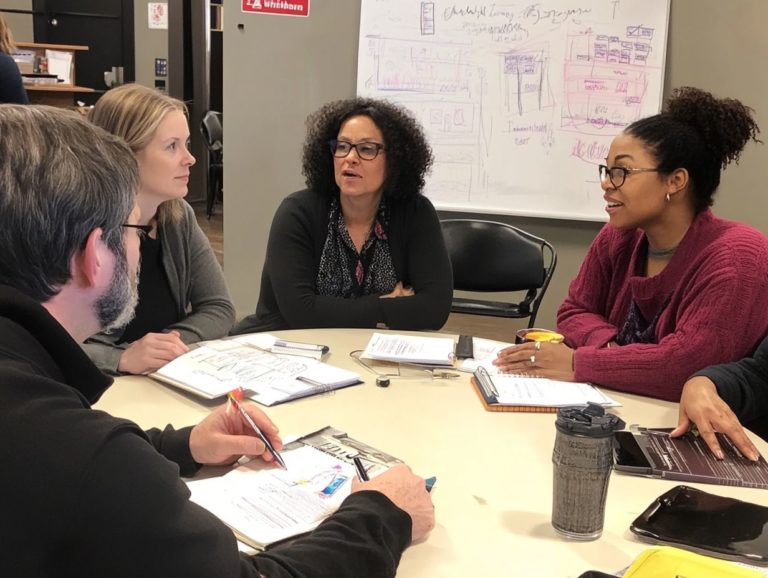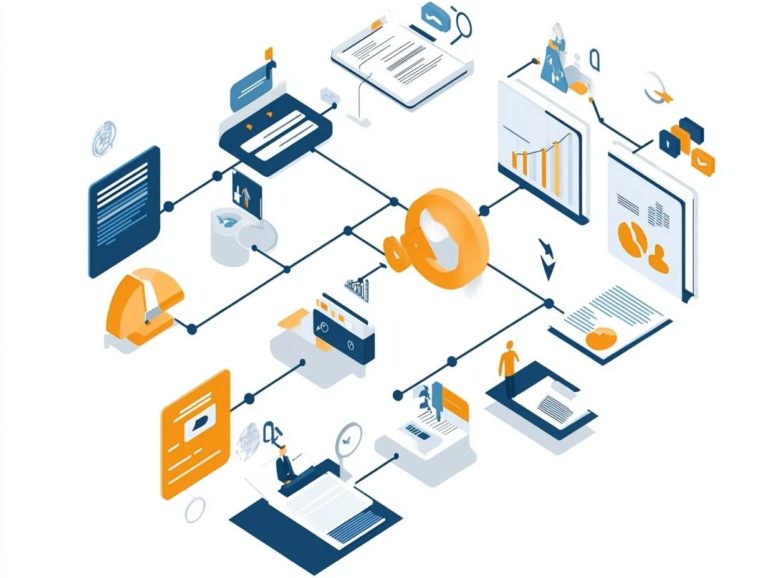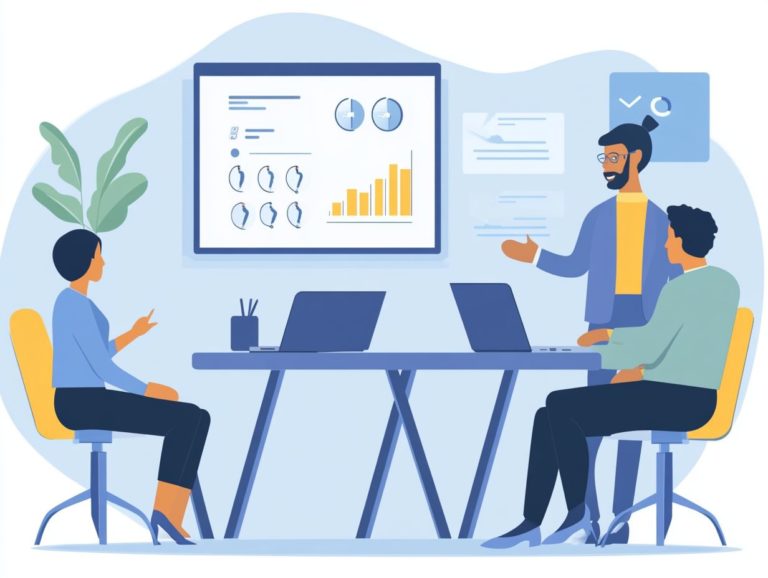How to Develop a Custom Corporate Training Program?
Corporate training is crucial in today s fast-paced business world. A well-structured program enhances employee skills and drives organizational success.
This article covers the key steps to develop a custom corporate training program. You’ll learn how to identify training needs, design, implement, and evaluate the program for maximum benefits.
Keep reading to transform your workforce and boost productivity.
Contents
- Key Takeaways:
- The Importance of Corporate Training
- Identifying Training Needs
- Designing a Training Program
- Implementing the Training Program
- Evaluating the Training Program
- Frequently Asked Questions
- 1. What is a custom corporate training program?
- 2. How do I know if my company needs a custom corporate training program?
- 3. How can I develop a custom corporate training program?
- 4. How long does it take to develop a custom corporate training program?
- 5. Can a custom corporate training program be delivered online?
- 6. How can I measure the success of a custom corporate training program?
- How to Develop a Custom Corporate Training Program
Key Takeaways:

- Corporate training improves skills and productivity, benefiting both employees and organizations.
- A thorough training needs assessment identifies specific areas to address.
- Clear goals and appropriate training methods are vital for success, along with regular evaluations for improvements.
The Importance of Corporate Training
Corporate training is a vital investment for organizations aiming to elevate employee development strategies and drive performance improvement. By embracing effective training methodologies, you can ensure your workforce is equipped with the essential skills, knowledge, and attitudes that align seamlessly with your organizational goals.
A well-designed corporate training program bridges skill gaps, boosts employee morale, and improves job performance. These elements are essential for your business’s growth and competitiveness in today s fast-paced landscape.
Benefits for Employees and Organizations
The benefits of corporate training are substantial, impacting both employees and organizations alike. You will see that it enhances engagement levels and fosters a culture of continuous learning, aligning with both your career objectives and your organization s goals.
Investing in customized training materials that cater to diverse learning preferences significantly elevates learner engagement. Research indicates that organizations with effective training programs experience a remarkable 24% increase in job satisfaction among employees, leading to lower turnover rates.
Moreover, tailored training approaches often correlate with a 30% improvement in retention rates, as employees feel more valued and understood. For instance, a case study of a tech company demonstrated that after implementing targeted training sessions, overall project success rates soared by 40%. This illustrates that corporate training not only cultivates skills but also directly boosts success and morale.
Identifying Training Needs
Identifying training needs is essential for a successful corporate training program. It ensures alignment between employee skills and organizational goals through effective feedback and learning analytics.
By honing in on these needs, you set the stage for a more impactful and tailored training experience.
Conducting a Training Needs Assessment
Conducting a training needs assessment requires you to analyze performance data, collaborate closely with HR, and apply instructional design principles to create relevant learning goals.
This process begins with collecting both quantitative and qualitative performance data, which uncovers specific skill gaps and highlights areas for improvement. Engaging with HR, or Human Resources, is vital; they offer valuable insights into organizational objectives and employee feedback that can shape your approach.
Once you’ve gathered the data, it s essential to establish clear, measurable learning goals. This ensures the training program aligns perfectly with the needs of employees and the overarching business objectives. By integrating these steps, you can develop training initiatives that effectively enhance workforce capabilities and drive significant performance improvements.
Designing a Training Program
When you embark on designing a training program, it s essential to adopt a thoughtful approach to instructional design. Begin by establishing clear learning objectives that guide the entire process.
Integrate captivating content that offers a variety of digital experiences, ensuring that your learners remain captivated and excited throughout their journey.
Setting Goals and Objectives

Setting clear learning objectives is essential for the success of any training program. These objectives guide the development of your training materials and provide a solid framework for tracking and evaluating performance.
Think of these objectives as your roadmap, ensuring that you and every participant understand what is expected and how the learning contributes to the organization. By aligning these objectives with employee onboarding and development goals, you create a cohesive learning experience that addresses individual aspirations and the company’s needs.
Implementing metrics to evaluate training effectiveness is crucial. These metrics measure progress and highlight areas needing improvement. This comprehensive approach ensures your training isn’t just a cookie-cutter initiative but a dynamic tool for growth and performance enhancement.
Selecting Training Methods
Selecting the right training methods is essential for crafting a learner-centric environment where flexible learning methods can thrive, catering to diverse training needs and optimizing your training calendar.
Among the options available, instructor-led training stands out for its direct interaction. It allows participants to ask questions and engage in real-time discussions, significantly enhancing understanding. On the flip side, e-learning offers unparalleled flexibility, enabling employees to learn at their own pace and revisit content whenever they need. A hybrid approach merges the strengths of both methodologies, creating a well-rounded training experience.
By integrating adaptive learning strategies, you can customize programs to align with individual learning styles and paces, ensuring that each employee enjoys a tailored experience. Personalization boosts engagement. It also improves retention and performance, creating a skilled workforce.
Implementing the Training Program
Implementing the training program is a pivotal phase that demands careful planning and teamwork. By ensuring seamless employee onboarding, you can maximize training effectiveness through captivating delivery methods that ignite excitement.
Preparing for the Training
Preparing for the training requires you to organize your materials meticulously and create an inviting learning environment that promotes engagement and facilitates seamless employee onboarding.
Consider the logistics, such as scheduling sessions that accommodate different time zones and ensuring that the necessary technology is readily available. A thoughtfully planned approach to setting up digital experiences can significantly boost engagement and retention, allowing participants to connect meaningfully with the content.
Keep accessibility at the forefront by ensuring that all training materials are available in various formats to meet diverse learning needs. By making the content relevant and adaptable, you enrich the learning journey, ultimately enhancing the overall success of the training initiative.
Delivering the Training
Delivering training effectively is paramount for achieving the desired learning outcomes. You should embrace a focus on the learner and utilize various training methods to keep engagement levels soaring.
This strategy encourages you to explore a range of techniques, such as interactive workshops, multimedia presentations, and peer collaboration. Each method is carefully tailored to meet the unique needs of your audience. Incorporating learning analytics which involves collecting data on learner performance is vital in this journey, as it allows you to track learner progress and interactions.
By analyzing this data, you can make informed adjustments to your methods, ensuring that the learning experiences resonate more profoundly with participants. This continuous cycle of assessment and adaptation boosts engagement and enhances knowledge retention, ultimately paving the way for more successful training outcomes.
Evaluating the Training Program
Evaluating the training program is essential for gauging its effectiveness and ensuring that it aligns with both the training objectives and the learners’ needs.
By systematically collecting feedback and tracking performance, you can gain valuable insights that enhance the overall experience and outcomes of the program.
Measuring Effectiveness and Making Improvements

Measuring the effectiveness of your corporate training programs requires a careful look at performance data and learner engagement. This process helps you pinpoint areas for continuous improvement and refine your training strategies.
By employing a variety of methods such as pre- and post-training assessments, surveys, and on-the-job performance metrics you can gain invaluable insights into how well your training initiatives resonate with participants. Feedback from learners not only highlights strengths and weaknesses but also offers suggestions to enhance the overall experience.
Analyzing these diverse data points enables you to make informed decisions. This leads to iterative improvements that more effectively address skill gaps. Ultimately, this reflective approach cultivates an environment of continual learning and development, ensuring that your training remains relevant and impactful in achieving your corporate objectives.
Frequently Asked Questions
1. What is a custom corporate training program?
A custom corporate training program is a specialized training program designed specifically for a company or organization to meet their unique needs and goals, including various types of corporate training programs.
2. How do I know if my company needs a custom corporate training program?
If your company is facing challenges such as low employee engagement, high turnover rates, or a need for specific skills and knowledge, a custom corporate training program can help address these issues. Understanding what to expect from a corporate training session can further improve overall performance.
3. How can I develop a custom corporate training program?
To develop a custom corporate training program, you should first identify the specific goals and objectives you want to achieve. Then, conduct a training needs assessment to determine the specific training needs of your employees. For insights on creating an effective program, consider exploring what makes a successful corporate training program. Finally, work with a professional training provider to design and implement the program.
4. How long does it take to develop a custom corporate training program?
The timeline for developing a custom corporate training program can vary depending on the complexity and scope of the program. It can take anywhere from a few weeks to several months, but it is important to prioritize quality and effectiveness over speed. For those looking to enhance their training efforts, understanding how to start a corporate e-learning program can be invaluable.
5. Can a custom corporate training program be delivered online?
Yes, many custom corporate training programs can be delivered online through virtual platforms. This is a smart and efficient choice for companies looking to enhance training!
6. How can I measure the success of a custom corporate training program?
To measure the success of a custom corporate training program, you can analyze feedback, performance metrics, and learner engagement to assess its effectiveness and impact.
How to Develop a Custom Corporate Training Program
To create a successful program, first identify your goals. Next, assess the training needs of your employees.
Work with a professional training provider to design and implement the program efficiently.
How long does it take to develop a custom program? Development can take a few weeks to several months. Always prioritize quality for the best results!
Can these programs be delivered online? Yes, many can be offered through virtual platforms. This option is convenient and cost-effective, especially for remote teams.
Successful programs are measured through employee feedback and performance indicators, which are metrics used to evaluate success. Set clear goals and evaluate the program regularly.







